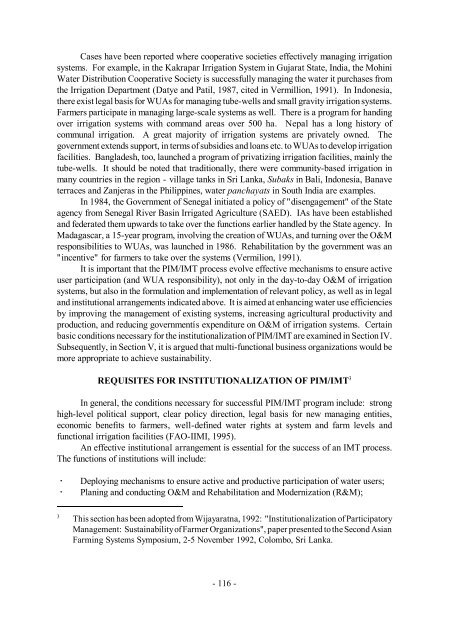Organizational Change for Participatory Irrigation Management
Organizational Change for Participatory Irrigation Management
Organizational Change for Participatory Irrigation Management
Create successful ePaper yourself
Turn your PDF publications into a flip-book with our unique Google optimized e-Paper software.
Cases have been reported where cooperative societies effectively managing irrigation<br />
systems. For example, in the Kakrapar <strong>Irrigation</strong> System in Gujarat State, India, the Mohini<br />
Water Distribution Cooperative Society is successfully managing the water it purchases from<br />
the <strong>Irrigation</strong> Department (Datye and Patil, 1987, cited in Vermillion, 1991). In Indonesia,<br />
there exist legal basis <strong>for</strong> WUAs <strong>for</strong> managing tube-wells and small gravity irrigation systems.<br />
Farmers participate in managing large-scale systems as well. There is a program <strong>for</strong> handing<br />
over irrigation systems with command areas over 500 ha. Nepal has a long history of<br />
communal irrigation. A great majority of irrigation systems are privately owned. The<br />
government extends support, in terms of subsidies and loans etc. to WUAs to develop irrigation<br />
facilities. Bangladesh, too, launched a program of privatizing irrigation facilities, mainly the<br />
tube-wells. It should be noted that traditionally, there were community-based irrigation in<br />
many countries in the region village tanks in Sri Lanka, Subaks in Bali, Indonesia, Banave<br />
terraces and Zanjeras in the Philippines, water panchayats in South India are examples.<br />
In 1984, the Government of Senegal initiated a policy of "disengagement" of the State<br />
agency from Senegal River Basin Irrigated Agriculture (SAED). IAs have been established<br />
and federated them upwards to take over the functions earlier handled by the State agency. In<br />
Madagascar, a 15-year program, involving the creation of WUAs, and turning over the O&M<br />
responsibilities to WUAs, was launched in 1986. Rehabilitation by the government was an<br />
"incentive" <strong>for</strong> farmers to take over the systems (Vermilion, 1991).<br />
It is important that the PIM/IMT process evolve effective mechanisms to ensure active<br />
user participation (and WUA responsibility), not only in the day-to-day O&M of irrigation<br />
systems, but also in the <strong>for</strong>mulation and implementation of relevant policy, as well as in legal<br />
and institutional arrangements indicated above. It is aimed at enhancing water use efficiencies<br />
by improving the management of existing systems, increasing agricultural productivity and<br />
production, and reducing governmentís expenditure on O&M of irrigation systems. Certain<br />
basic conditions necessary <strong>for</strong> the institutionalization of PIM/IMT are examined in Section IV.<br />
Subsequently, in Section V, it is argued that multi-functional business organizations would be<br />
more appropriate to achieve sustainability.<br />
REQUISITES FOR INSTITUTIONALIZATION OF PIM/IMT 3<br />
In general, the conditions necessary <strong>for</strong> successful PIM/IMT program include: strong<br />
high-level political support, clear policy direction, legal basis <strong>for</strong> new managing entities,<br />
economic benefits to farmers, well-defined water rights at system and farm levels and<br />
functional irrigation facilities (FAO-IIMI, 1995).<br />
An effective institutional arrangement is essential <strong>for</strong> the success of an IMT process.<br />
The functions of institutions will include:<br />
Deploying mechanisms to ensure active and productive participation of water users;<br />
Planing and conducting O&M and Rehabilitation and Modernization (R&M);<br />
3 This section has been adopted from Wijayaratna, 1992: "Institutionalization of <strong>Participatory</strong><br />
<strong>Management</strong>: Sustainability of Farmer Organizations", paper presented to the Second Asian<br />
Farming Systems Symposium, 2-5 November 1992, Colombo, Sri Lanka.<br />
- 116 -
















